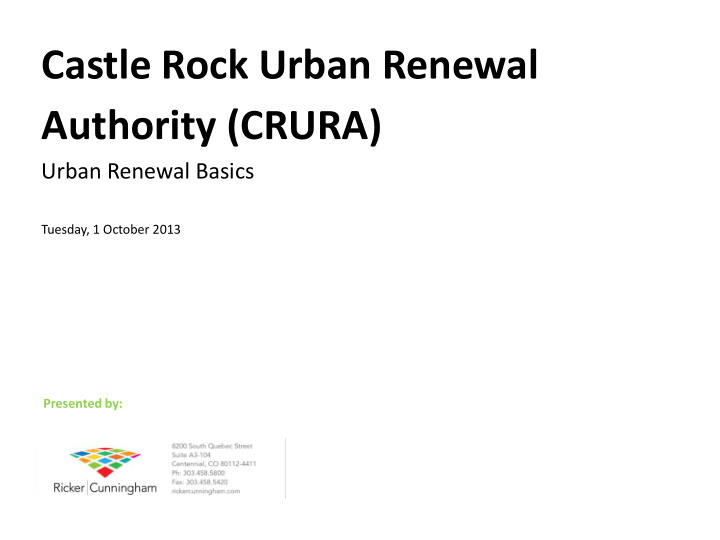



Castle Rock Urban Renewal Authority (CRURA) Urban Renewal Basics Tuesday, 1 October 2013 Presented by:
After forming the Authority … Creating an Urban Renewal Area Determine official survey area boundaries Notify property owners within those boundaries that a survey is being conducted Verify the presence and location of “blighting” conditions (field survey) Prepare conditions survey ---------------------- Define boundaries for urban renewal area (may be the same as survey area boundary or less) Complete market analysis or forecast of market growth for early TIF districts Define future role of urban renewal area in the community Prepare urban renewal plan (s) 2
Creating an Urban Renewal Area (cont’d) Complete financial analysis (tax increment finance – TIF) Complete impact analysis (es) for impacted taxing bodies Notify property owners and tenants within the plan boundaries of the date of a public hearing to consider adoption of the plan (s) Present findings and plan to Planning Commission (for consideration of its consistency with the community plan) Present survey findings to urban renewal entity and council for acceptance and urban renewal plan to urban renewal entity and council for adoption --------------------------- Work with owners and developers to determine possibilities for redevelopment Implement plan 3
Defining the Boundaries State statute says … “as narrowly as possible” however, it also says that you must be a viable on-going concern Ownership conditions (pro- or anti -, public, residential vs. commercial, assemblages vs. fractured) Political opinions, concerns, objectives Prevailing policy and regulating documents Community vision Issues to be addressed and their associated costs Tax Increment Financing (TIF) potential of the area 4
Colorado Urban Renewal Statute 11 Qualifying Factors a. Deteriorated or deteriorating structures b. Defective or inadequate street layout c. Faulty lot layout in relation to size, adequacy, accessibility, or usefulness d. Unsanitary or unsafe conditions e. Deterioration of site or other improvements f. Unusual topography or inadequate public improvements or utilities g. Defective or unusual conditions of title rendering the title non-marketable h. Conditions that endanger life or property by fire or other causes i. Buildings that are unsafe or unhealthy for people to live or work in j. Environmental contamination of buildings or property k5. Existence of health, safety, or welfare factors requiring high levels of municipal services or substantial underutilization or vacancy of buildings, sites, or improvements 5
How much “blight” is enough? Normally, a determination of blight is based upon an area “taken as a whole ,” and not on a building-by-building, parcel-by-parcel, or block-by-block basis. The urban renewal statute does not require a certain “quantity” of conditions within any one of the blight factors to be found in order for that blight factor to be considered present in the area. -------------- If there is no objection by the property owner or owners and the tenant or tenants of such owner or owners, if any, to the inclusion of such property in an urban renewal area, ‘blighted area’ also means an area that, in its present condition and use and, by reason of the presence of any one of the factors... If private property is to be acquired by eminent domain, then “blighted area” means an area that, in its present condition and use and, by reason of the presence of at least five of the factors... Otherwise , by reason of the presence of any four of the factors... 6
Content of the Plan Plan is very general – supported by findings of blight (conditions survey) and impact report Elements include description of – area purpose conditions of blight relationship to comprehensive plan objectives implementation approach financing approach Supplemented by - overlay plans, zoning, design standards, etc. 7
Uses for TIF Dollars Tax Increment Financing (TIF) is a unique mechanism that enables an urban renewal authority or board to use the net new tax revenues generated by projects within a designated urban renewal area to help finance future improvements. TIF is a new source of tax revenue, not an additional tax, that would not be available but for new investment. Finance the issuance of bonds Reimburse developers for a portion of their project costs Acquire property Make improvements -- public benefit, support redevelopment effort … correct problems and finance improvements … 10
Property Owner Impacts What will the urban renewal plan do for you? Allow more flexibility in what you can do with your property in the form of mixed-use opportunities (e.g., residential) Allow your taxes to be spent on improvements in your immediate “neighborhood” Address land use and transportation planning issues Identify capital improvements needed to accommodate future investment Potentially provide property redevelopment / expansion financial assistance What won’t the urban renewal plan do for you? Prevent you from continuing your current business or land use Raise property tax mill levy sales tax rate Force you to improve your property (especially at a higher standard than outside the area) Diminish the value of your property Prevent you from selling your property … see Town website for more examples … 12
Recommend
More recommend